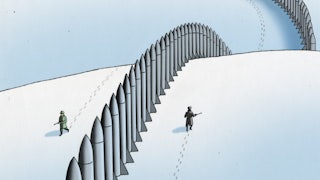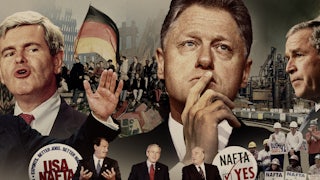In the summer of 1959, an attractive American-style house was built in Moscow, fully furnished with the amenities that any working American could supposedly afford. But it was not meant for anyone to live in. The previous year, officials from the United States and the Soviet Union had agreed to participate in a cultural exchange program intended to foster mutual understanding and, implicitly, measure one country’s standard of living against the other’s. The ersatz home was the centerpiece of the U.S. exhibit, and Vice President Richard Nixon was in the Soviet capital ahead of its opening. Guiding Soviet Premier Nikita Khrushchev through the installation, Nixon gloated about the prosperity that postwar American capitalism was delivering its citizens.
Khrushchev responded by noting astronomical leaps in development under the Soviet system, pointing out that housing was a right rather than a privilege on his side of the Iron Curtain. In less than a decade, he said, the USSR would best the U.S. in material abundance. “As we pass you by, we’ll wave ‘hi’ to you,” Khrushchev added, “and then if you want, we’ll stop and say, ‘please come along behind us.’”

As historian Fritz Bartel argues in The Triumph of Broken Promises: The End of the Cold War and the Rise of Neoliberalism, the early years of the Cold War were defined by the question of whether East or West could offer their citizens the fullest, most comfortable existence. It was not a given that U.S.-style capitalism would win that argument. The furnishings of the model U.S. home in Moscow were props in an elaborate ideological showcase of the good life, a flash point in a broader struggle for credibility. As superpowers vied, they argued in myriad ways that their model could best provide all of the trappings of modernity. Bartel calls this dynamic “the politics of making promises.”
But as the global economy was rocked by crises in the 1970s, these governments could no longer sustain the growth that buttressed their boasts two decades before. The final years of the Cold War became a contest over who could best oversee the transition from a political economy geared toward the creation and dispersal of plenty to the imposition and management of austerity. Bartel dubs this stage “the politics of breaking promises.” As the title of the book suggests, the post–Cold War world would be indelibly marked by a retraction of social democratic commitments. Liberal democracy and neoliberal economies prevailed, according to Bartel, because “they were the best political and economic systems for breaking promises.”
The promises Bartel refers to were both broad and narrow. At their most aspirational and vague, they spoke to the transformative potential of this or that economic regime. But there were also more specific pledges that proved unsustainable. One of these was the guarantee of heavily subsidized energy the Soviet Union offered its allies, a crucial promise in the wake of the 1973 oil shock that threw the global economy into disarray.
In retaliation for the U.S. supporting Israel in the Yom Kippur War, the Organization of Petroleum Exporting Countries abruptly increased the price of a barrel of oil by 70 percent, raising the cost of fuel and plastics virtually overnight. “American consumers facing the prospect of a cold winter may, at the moment, be more concerned over a cold home, school or an empty gasoline tank,” Gerd Wilcke wrote in The New York Times in November 1973, but under a sustained oil shortage, “not only would thousands of products become scarce, but many thousands of people would lose their jobs.” And so they did. Indeed, the lingering effects of the oil shock would call into question the solidity of free-market capitalism, particularly given its increasing reliance on cheap oil and interdependence with unfriendly foreign governments. For millions of Americans, the comfortable middle-class lifestyle represented by that model home in 1959 inched out of reach. Socialists like Michael Harrington envisioned “the twilight of capitalism” while the liberal administration of Jimmy Carter grappled haplessly with stagflation.
The toll of pricier oil was also deeply felt on the periphery of global capitalism. Brazil, for example, saw a period of unprecedented economic growth grind to a halt as a result of the oil shock, robbing the anti-Communist dictatorship of the positive narrative it used to justify its hold on power since 1964. For leaders watching from Eastern Europe, “the oil crisis was the clearest sign yet that capitalism was prone to crisis and doomed to failure.” They were confident that economic planning and effective management of their own energy resources would enable the Eastern bloc to withstand the astronomical rise in global oil prices.
Yet, as Bartel discusses at length in his opening chapter, if “the crisis at first appeared to validate the fundamental differences between democratic capitalism and state socialism, in time it demonstrated that both blocs were subject to the pressures of the same world market.” For better or for worse, East and West were not as insulated from each other as they might have thought. Bartel shows that over the course of the 1970s, the Eastern bloc became increasingly indebted to Western banks, a process that sucked those countries into a competitive global trade regime in which they were not equipped to take part.
Many accounts blame Mikhail Gorbachev for much of the economic suffering in the countries of the former Soviet Union in the 1990s. Some see him as a courageous reformer committed to a more democratic socialist vision, while others depict him as a toady who needlessly compromised the livelihoods of millions of people by subjecting them to a traumatic economic transition. But Bartel does not place Gorbachev at the center of his narrative of the Soviet Union’s collapse, reminding readers Gorbachev was not the first to advocate reforms to its economy and political culture. The difference in his time was that the world faced a new fiscal paradigm. “Contrary to the historical memory that prevails today,” he writes, the rising tide of popular disaffection in the Eastern bloc “had not originated in the socialist world with perestroika but rather in the world economy with the oil crisis of 1973 and the sovereign debt that followed from it.” If Moscow had once seen itself as insulated from the volatility of international capital flows, by the mid-1980s it watched as a wave of “economic adjustment” rose to “wash away the division of Europe completely.”
Rising popular discontent fueled Gorbachev’s liberal turn. “Indeed,” Bartel writes, “the first reason democracy and freedom of expression emerged in the Soviet Union was because of their potential to coerce.” Faced with growing budget deficits, inflation, and shortages as a result of the global oil crisis and a disastrous adventure in Afghanistan, Soviet leaders recognized that “the burden of economics demanded a new form of politics,” one in which the state did less for—and to—its citizens. If the people had even a nominal say in the direction of the country, they might feel more invested in the survival of the existing order; a degree of popular participation might give the state enough credibility to implement an austere economic agenda. Alexander Yakovlev, the man sometimes referred to as the godfather of glasnost, underscored this point to his friends in the Politburo: “When people talk about democracy, they presuppose some amorphous notion, like liberalization.… However, in reality, democracy is discipline.” Gorbachev in 1987 stated openly that the Soviet Union was committed to “the path of democracy” because “it provides the strongest grip on power.” This was the hope, anyway.
But carrying out the basic elements of a cost-cutting economic adjustment proved “politically impossible,” Bartel argues, particularly when it came to restructuring the system of fixed prices. In practical terms, prices for everything had to go up. It had always been difficult for Soviet leaders to square a diminution of living standards with the forward march of progress embedded in so much official Communist Party rhetoric. Ronald Reagan too, of course, faced a mounting national debt and deficits of his own, but he could count on Paul Volcker at the Fed raising interest rates to astronomical highs, driving the country into successive recessions and hollowing out U.S. manufacturing. “Gorbachev,” Bartel notes, “had no equivalent savior.”
It was particularly difficult for the USSR to adapt economically as it struggled to maintain its position in the race for global dominance. In 1987, Gorbachev went abroad to present himself as an affable, unthreatening counterpart to the U.S., hoping that in a climate of tranquility he could slash the military budget. It became increasingly clear to officials within the USSR and abroad that sustaining the Soviet imperial apparatus—and by extension the forceful policing of its own people—was increasingly untenable. In private, Gorbachev told Czechoslovakian leaders that he would not implement perestroika “at [your] expense. But do not expect to live at our expense either.” He was signaling a narrowing of the Soviet Union’s horizons—a vision that was fundamentally at odds with popular demands for a basic standard of living, subsidized in some way by the state.
Bartel’s work is especially intriguing as a story of how the Cold War was won. The familiar narrative is that Reagan’s military buildup drove the Soviet Union into the ground as it struggled to maintain strategic parity; that this weakness paved the way for the expansion of free markets and liberal democracy in Eastern Europe and beyond. What Bartel shows, however, is that the process of raising material expectations, falling short of meeting them, and then attempting to convince millions of ordinary people to accept new, lower standards was outrageous for those eking out a living in Poland, Hungary, East Germany, and elsewhere in the Eastern bloc. The inability to restrain or redirect this disillusion proved fatal for the Soviet Union.
Economic conditions changed from the 1950s to the 1980s and the calculations that leaders made about how to hold onto power changed accordingly. The rapid global growth of the postwar period cooled by the 1970s, but “people’s expectations of social and material progress did not.” Neoliberalism was so attractive to so many policymakers that even Soviet leaders were privately speaking in much the same terms as their capitalist counterparts, bemoaning their citizens’ “egalitarian mood” and wrestling with how to reintroduce personal incentives into a workforce that had grown unaccustomed to market stimuli. “Democratic capitalist governments made fewer promises to their people,” Bartel writes, “and this meant they had fewer promises to break.” When showing Khrushchev around the model U.S. home in 1959, Nixon had spoken in terms of affordability, not rights. Casting someone from her home when she can no longer pay a mortgage fits neatly within a framework of hyper-individualized liberal democratic capitalism. How to cast a person from their home when they have a right to it? The tension between promising and delivering, the fundamental challenge of government, broke the Soviet Union.
But Western countries also made assurances to their citizens, foremost among them being the prosperity of the American dream—the abiding notion that if one follows the rules and applies himself in the U.S., he will reap meaningful material benefits. One of the strengths of this notion as a national myth, it transpires, is that it does not depend on widely shared prosperity. The idea at its core—of earning, of striving for a good life—was fully compatible with the precepts of neoliberalism that prevailed as the Cold War was winding down: Individual attainment, not personal investment in the well-being of others or reliance on government, is the foremost marker of success. The warm ideal of meritocracy wrapped the chilly essence of neoliberalism. The people who got left behind in this new economic order were themselves responsible for their sorry fate. The systemic failure of the state to care for its people was thus recast as a haze of millions of atomized individual shortcomings.
What remains unclear, however, is how long the West can continue to break promises without inspiring new political formulations. Eric Hobsbawm wrote almost 30 years ago that “the history of the twenty years after 1973 is that of a world which has lost its bearings and slid into instability and crisis.” The last decade has felt that way as well. The U.S. today faces increasing geopolitical competition from China, a country that has taken pains to show it is not a military threat to the U.S. even as it steadily expands its diplomatic and economic reach around the world. Meanwhile, in the U.S., a rejuvenated socialist movement and right-wing extremism pick at the scabs of the existing order, the former positing emancipatory aims against the violent exclusionary goals of the latter. At home and abroad, we may well have inadvertently entered a new era of relevance for the politics of making promises.






